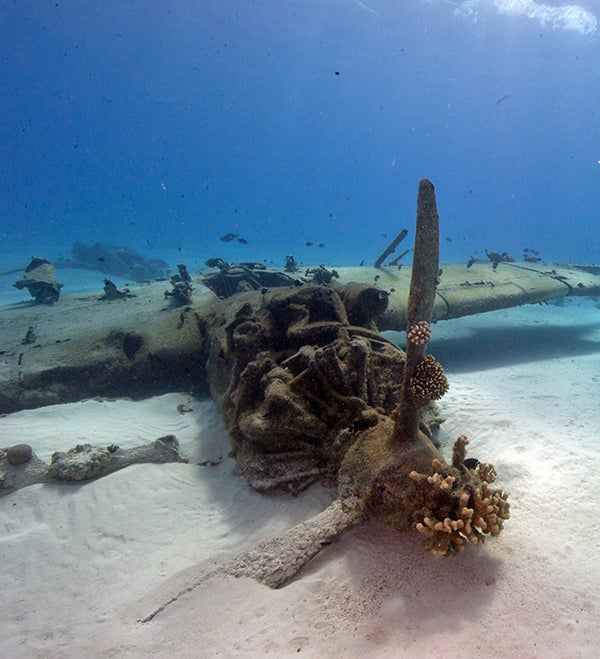ECU conducts cross-disciplinary research, education on sunken WWII aircraft in the Pacific

Lost WWII aircraft sunken in Saipan’s lagoon. (Contributed photo)
Download full-resolution version
East Carolina University’s Program in Maritime Studies and Department of Biology have received a National Center for Preservation Technology and Training grant totaling $29,652 from the National Park Service. The funds will support field work and laboratory analysis as part of a project focused on identifying the preservation threats of crashed World War II aircraft.
On the 75th anniversary of the Battle of Saipan, a major turning point in WWII, an interdisciplinary team of researchers, led by archaeologists Dr. Jennifer McKinnon and Dr. Nathan Richards and microbiologist Dr. Erin Field, seek to better understand the corrosive forces that threaten American aircraft associated with the battle. Specifically, the team is interested in studying the microorganisms that grow on the surfaces of the wreckage in the water.
Previous research has revealed that certain species of bacteria, fungi and other microbes can accelerate the corrosion of historic wrecks. The project would be the first of its kind to thoroughly investigate the microorganism community of a submerged WWII aircraft wreck.
The team will use the grant funds to travel to Saipan in March 2020 to gather samples from the surfaces of three American aircraft lost during the Battle of Saipan. The team will host an education day with Kagman High School, one of three public high schools on Saipan’s Northern Mariana Islands. The team will work with the school’s history and science classes to include presentations, 3D media demonstrations and hands-on experiments on WWII history, research and scientific methods. Funds will be used to conduct DNA analysis under Field’s supervision.
“We are excited to work together through this cross-discipline research and education to develop new methods for monitoring and addressing biocorrosion that can ultimately help preserve these historical WWII aircraft,” said Field.
It is the team’s hope that results will identify microorganisms associated with instances of corrosion found on downed aircraft. Furthermore, it is the desire of the research team to combine the study results with other projects and laboratory experiments focused on additional sources of corrosion to refine the predicted decay trajectories of the wrecks, while also aiding those tasked with preserving WWII maritime heritage.
###
ECU News Services
Howard House, 1001 E. Fifth Street
Greenville, NC 27858
ecunews@ecu.edu
Phone: 252-328-6481
news.ecu.edu
Contact: Dr. Jennifer McKinnon, associate professor and director of graduate studies, Department of History and maritime studies program, mckinnonje@ecu.edu, 252-328-6788